GILSONITE BENEFITS IN ASPHALT PAVEMENT
SCIENTIFIC STUDY PROVES GILSONITE BENEFITS IN ASPHALT PAVEMENT
A study by the Western Regional Super Pave Center at the Department of Civil and Environmental Engineering of the University of Nevada, Reno, proved that Gilsonite-modified binders significantly extend the useful life of asphalt pavement. This is good news for agencies looking to reduce the long-term costs of asphalt pavement maintenance.
Findings from comprehensive testing demonstrated that Gilsonite-modified binders showed significant improvement in:
Tensile strength
The addition of Gilsonite significantly increased both the unconditioned and moisture-conditioned tensile strength.
Compressive strength
Gilsonite-modified binders showed significant improvement in compressive strength.
Rutting strength
Gilsonite-modified binders significantly increased projected pavement life. In all but one case, adding Gilsonite yielded a ten-fold increase.
Fatigue resistance
The projected pavement life is to times longer with the Gilsonite-modified binders.
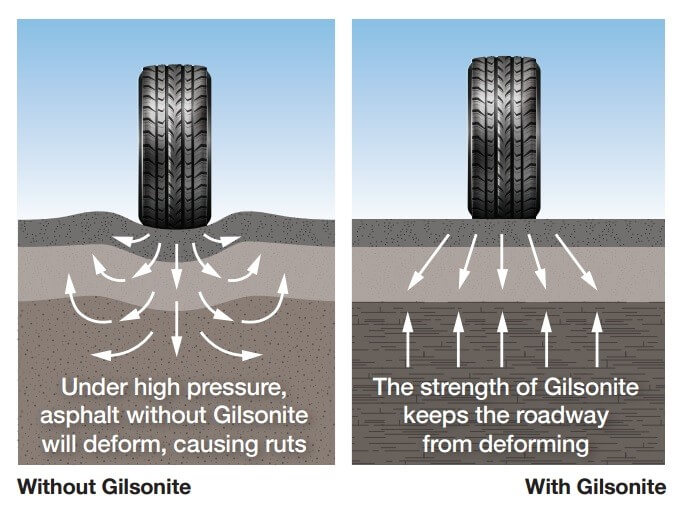


Gilsonite reduces material and saves money
Gilsonite increases the viscosity of asphalt so roadways resist deformation and fatigue, even under temperature extremes unlike other modifications or high modulus asphalt based on RAP.
Industry reports of Gilsonite-modified asphalt lasting more than twice as long as unmodified mixtures is common. In addition, the high modulus provided by Gilsonite allows the base and binder courses to be up to 20% thinner while still providing the same level of performance, enabling the use of less material. Gilsonite can also act as a lower-cost, performance-enhancing extender in a mixture including SBS polymers.
By significantly extending the useful life of asphalt pavement and allowing a reduction in the amount of paving material required, Gilsonite has proven to offer substantial cost effectiveness.
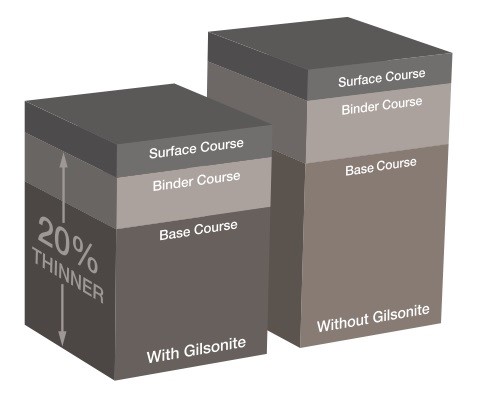
Gilsonite is superior for recycling asphalt
Only Gilsonite-modified binder bonds with and stabilizes recycled binder, making recycled asphalt as strong and durable as new. By contrast, polymer-modified binders form large molecules that cross-link into a matrix that recycled binder cannot bond with, leaving pavement vulnerable to breakdown.

No other additive can match all the benefits of Gilsonite:
High strength and fatigue resistance
Reduced temperature susceptibility
Superior deformation resistance
Increased resistance to water stripping
Reduced pavement thickness
Safe and environmentally responsible
Gilsonite is proven to perform
Gilsonite unique properties make a road that is less susceptible to high-temperature and deformation performance issues. Gilsonite can be added directly at the hot mix plant without additional equipment.
Gilsonite makes roads stronger
To last longer Compared to a typical road that might last years, Gilsonite produces a stronger, better-bonded asphalt that can last 25 years.
Use Gilsonite as a cost-effective component of modified polymer
Modified polymer additives can increase binder performance under certain extreme conditions. However, SBS polymers cost more than twice as many as Gilsonite. A more cost-effective solution is to combine Gilsonite and SBS polymers to achieve the desired grade.
Asphalt with Gilsonite resists rutting
Gilsonite increases the viscosity of asphalt so roadways resist deformation and fatigue, even under temperature extremes unlike other modifications or high modulus asphalts based on RAP.
Gilsonite outperforms other bitumen modifiers
Unique source with high purity deposits
Extracted with little contamination
Ideal softening point for bitumen modification
Natural antioxidation properties resist age hardening and degradation
Building stronger roads for more than 100 years
Gilsonite is the trademarked name for entities, a natural asphalt discovered in the Uinta Basin of northeastern Utah. Since the 1860s, We Gilsonite Company has been producing Gilsonite to strengthen asphalt roads. Gilsonite is readily available in Meltable bags.
Gilsonite is versatile, cost-effective and adds a new dimension of strength to asphalt.
Gilsonite is a naturally occurring hydrocarbon resin that adds tremendous strength, durability, and longevity to asphalt roads. It is a cost-effective additive with unmatched performance.
Evaluation of Gilsonite-modified asphalt mixtures
Cost-effective additive improves strength, reduces rutting and cracking
Gilsonite has been used as an additive to enhance the performance of asphalt pavements for more than 100years. While field experience had demonstrated the advantages by using Gilsonite, the unique properties of Gilsonite-modified asphalt had not been well-documented due to the lack of a comprehensive evaluation.
However, a 2015study by the Western Regional Super Pave Center at the Department of Civil and Environmental Engineering of the University of Nevada, Reno, thoroughly analysed various asphalt pavements using the latest advancements in materials testing, pavement modelling, and life-cycle analysis.
Key points of the study
The evaluation was conducted under rigorous standards:
An independent supplier provided control samples and Gilsonite-modified versions of two performance grades (PG) of Asphalt: PG 64-28, indicating performance engineered for a pavement temperature range of 64C to 28C and PG 76-16, designed for a pavement temperature range of 76C to 16C.
All asphalt binders met the applicable state highway agencies specifications based on the Super pave PG System for Asphalt Binders.
The optimum binder content (OBC) of each asphalt mixture was identified by following the Super pave Volumetric Mix Design Method.
Laboratory equipment included the industry recognized Asphalt Mixture Performance Tester (AMPT).
The engineering properties of the asphalt mixtures were measured at their OBCs in terms of the dynamic modulus E* master curve.
The following performance characteristics of the asphalt mixtures were evaluated:
Resistance to rutting in terms of the Flow Number
Resistance to thermal cracking in terms of fracture temperature and fracture stress
Resistance to fatigue cracking in flexural bending
Quantifying performance
Gilsonite has long been used to increase the performance of asphalt binders. Now, the respected study has documented its advantages.
Super pave PG characteristics used in testing
The Super Pave Performance Grading (PG) system uses the rheological properties of the asphalt binder to identify its performance under the prevailing environmental conditions at the location of the project. The characteristics of the binders used in the testing are summarized in the table below.
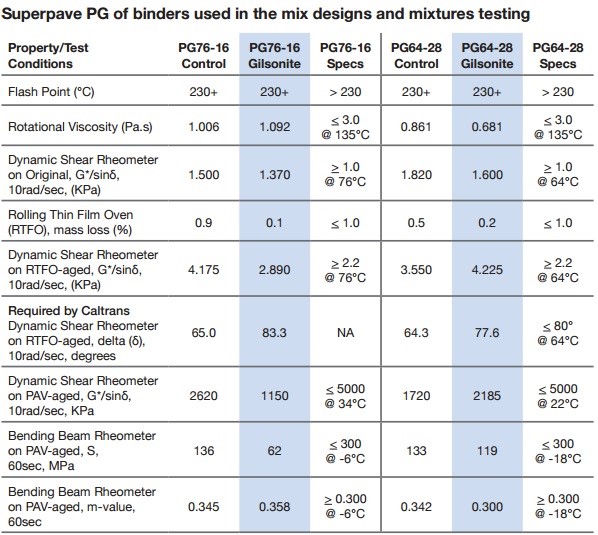
A close examination of the data shows that the addition of Gilsonite to the PG 76-16 mixture resulted in an asphalt binder that is less susceptible to short-term and long-term aging.
The industry standard
The most commonly used asphalt binder specifications in the U.S. are the Super pave Performance Grading (PG) system.
The same amount of binder, significant increases in strength
The Super pave system determines optimum binder content (OBC) based on an air voids level of 4% while meeting the remaining specified volumetric properties. Tests showed that the OBC was comparable to control samples and Gilsonite modified samples. The PG< 64-28 mixtures required the addition of hydrated lime in order to meet moisture sensitivity specifications. Gilsonite modified binders showed significant improvement in both tensile strength (TS) and unconfined compressive strength (UCS).
Summary of optimum binder contents and lime contents, unconditioned and moisture-conditioned TS and UCS properties of the various mixtures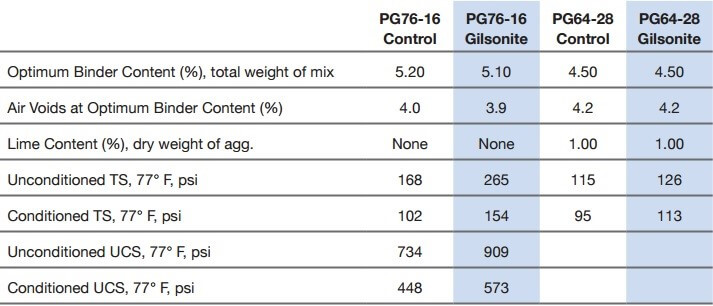
Dynamic modulus (E*) represents strength and stability
The American Association of State Highway and Transportation Officials (AASHTO) Mechanistic-Empirical Design uses the dynamic modulus (E*) master curve as the engineering property of the asphalt concrete layer to evaluate the structural response of asphalt pavement under various combinations of traffic loads, speed, and environmental conditions.
A higher E* property indicates a stronger, more stable mix and leads to lower stresses generated in the asphalt pavement under given loading and environmental conditions. The master curves data in the figure below indicate that the Gilsonite mixtures exhibit significantly higher E* properties compared to the control mixtures over the entire range of loading frequency.
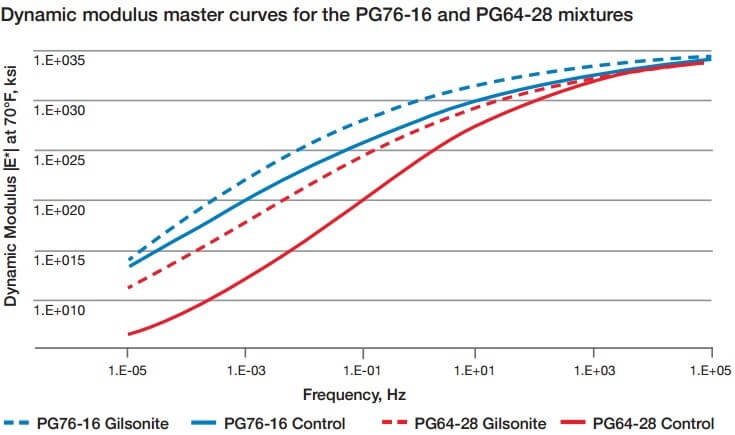
Capturing a range of variables
The dynamic modulus curve represents various combinations of loading frequency and temperature.
The data in the charts below compare the E* property of the mixtures at 10 Hz loading frequency representing a truck traveling at 60 mph (108kph). The 104F (40C) and 70F (21C) temperatures were selected since they represent the critical temperature of rutting and fatigue, respectively.
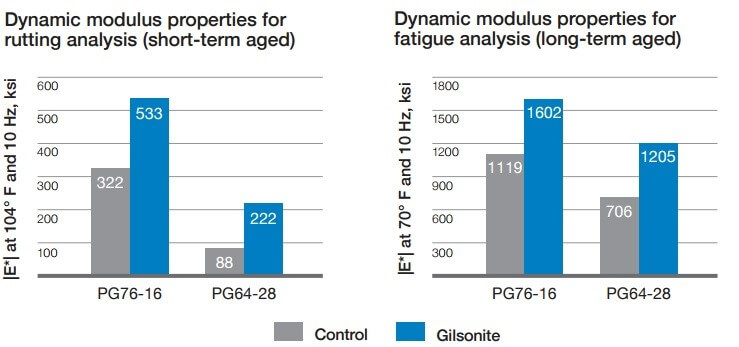
Gilsonite helps reduce rutting
Gilsonite increases the viscosity of asphalt so roadways resist deformation and fatigue, even under temperature extremes.
Resistance to rutting
The flow number property was evaluated to assess the rutting resistance of mixtures and to determine the rutting model coefficients.
The figure below compares the rutting models of mixtures. The PG 64- 28 Gilsonite-modified mixture exhibited a lower rutting model at 104F (40C) than the control mixture, indicating that the Gilsonite mix would offer higher resistance to rutting. The PG 76-16 Gilsonite-modified mixture exhibited a slightly higher rutting model at 104F (40C) than the control mixture.
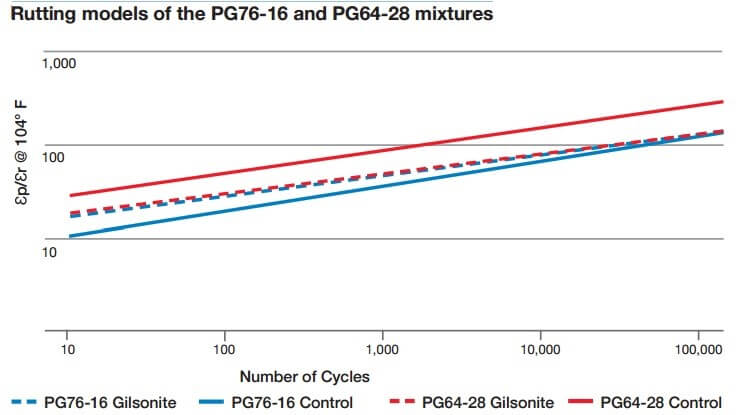
As shown below, adding Gilsonite to the PG 76-16 mixture increased the flow number at 60C (140F) by 66% (754 vs. 454). The addition of Gilsonite to the PG 64-28 mixture resisted the tertiary flow at 48C (118F). This indicates that Gilsonite-modified mixtures will offer significantly more resistance to rutting at the elevated pavement temperature.
Flow numbers of the PG 76-16 and PG 64-28 mixtures
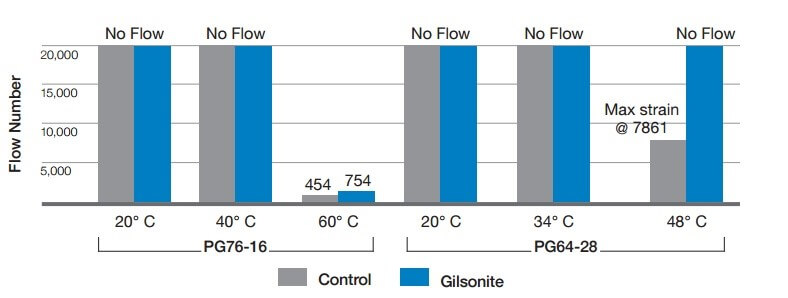
Relevant sample preparation
Since rutting is an early pavement life failure, the mixtures for the flow number test were only short-term aged.
Resistance to thermal cracking
To determine an asphalt mixtures ability to withstand low temperatures without cracking, tests measured both the temperature at which fracturing occurred as well as the stress required to initiate fractures.
In the PG 64-28 samples, both the control and the Gilsonite modified binders exceeded cold temperature specifications and thus were not expected to crack. The Gilsonite-modified PG76-16 sample showed cracking at 2C warmer than specifications. However, the calculated crack initiation energy was 20 higher than the control, so it would not be expected to crack under normal conditions.
Thermal cracking properties of the evaluated mixtures

Resistance to fatigue cracking
The resistance of the various mixtures to fatigue cracking was evaluated using the flexural beam test wherein a beam specimen was subjected to a constant bending moment over the centre portion of the specimen. Initial flexural stiffness was measured at the 50th load cycle. Fatigue failure was defined as the number of cycles corresponding to a 50% reduction in the initial stiffness.
The figures below compare the fatigue models of mixtures. The cycles-to-failure tests showed comparable results for the PG 76-16 control and Gilsonite modified samples. In the PG 64-28 mixtures, the control sample exhibited slightly higher fatigue relationships than the Gilsonite mixture. It should be noted, however, that the calculated values do not account for the effect of the much higher E* in the Gilsonite-modified binder.
Fatigue cracking models for the PG
Comments Off on Benefits of Gilsonite in Asphalt Pavement with 431 visit